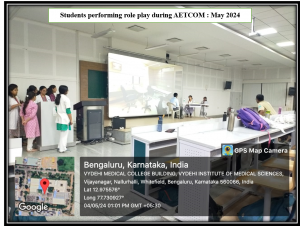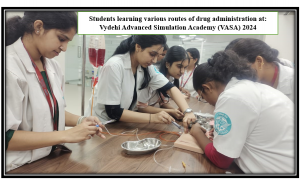Teaching/Learning Facilities
The department has one lecture hall with a sitting capacity of 250 students. There are four demonstration rooms, 6O sq. each, with a sitting capacity of 90 students. Teaching is conducted by means of black board, overhead projector, and LCD projector.
Undergraduate teaching
Students get hands on training during practical exercises with the help of computer aided simulation of animal experiments. They study the effects of various groups of drugs. They are also taught Clinical pharmacology and therapeutics in the form of clinical problems, Adverse drug reaction reporting, Drug dose calculations, dosage forms, Drug promotional literature, Pharmacokinetics exercises, Fixed Dose combinations, drug interactions & prescription writing. Students learn pharmacology through didactic lectures, tutorials, practical demonstration simulation experiments and role plays. They are regularly assessed by conducting class tests, formative and skill assessment both in theory and practical. Students interact with the faculty for clarifications.
Also, the department organizes one UG symposium where students get to present their slides, discuss, interact and learn presentation, communication, creativity, and collaboration skills.

Students are taught various parenteral routes of drug administration by practicing on mannequins at Vydehi Advanced Simulation Academy (VASA). The students of final year also come to the department for electives posting for gaining knowledge in clinical research and pharmacokinetics are explained to them.

Post graduate teaching
Post-graduate teaching is through seminars, journal clubs, case-discussion, animal experiments and clinical case discussions. They are also encouraged to participate in undergraduate teaching. They are motivated to participate in various workshops, CMEs and to present papers in conferences, and graduate with publications.
Faculty development
The faculty are qualified postgraduates with rich experience in teaching and research. They are encouraged to carry out research projects every year. There is a continuous training for the faculty on medical education technology to keep them abreast of the newer technology in teaching. Every faculty also mentors a small group of undergraduate students. They are in review boards of various journals, and also have exposure in RGUHS in various capacities.
Departmental library
The department has a separate library, measuring 30sq.m with the sitting capacity of 20 members. It has a collection of 180 books, of recent editions. It also has national and international journals.
Departmental Museum
The departmental museum is a part of central museum having an area of 125sq.m. The drug samples are classified and arranged system wise. There are around 150 drug samples including crude drugs and 60 catalogues which are available for student reference. It is also provided with 42 charts, 12 photographs and also separate section depicting the history of medicine.
Laboratories
The department experimental laboratory, which covers 320 square meters, can accommodate 150 students at a time. There are 26 computers installed where students are equipped with computer based learning. The clinical pharmacology and pharmacy laboratory is a 256 square meter facility equipped with advanced equipment’s like Rotarod apparatus, Analgesiometer, isolated organ bath, act photometer, electroconvulsiometer, Hebbs William maze, Spectrophotometer etc.
The Post Graduate Research Centre lab sprawls over 72 square meters and is equipped with a Student Organ Bath, bench kymograph, hot air oven and an incubator, spectrophotometer, Hebb’s William’s maze, Shuttle box, Open field apparatus, Physiograph, Eddy’s hot plate, open field apparatus, incubator, centrifuge, etc.
| Name of the Equipments |
|---|
| 1. BACTERIOLOGICAL INCUBATOR |
| 2. AUTOMATIC ELECTRIC RECORDING DRUMS |
| 3. HIGH POWER CENTRIFUGE FOR SEROLOGICAL AND ELECTRICAL WORKS |
| 4. ANALGESIOMETER |
| 5. ANIMAL WEIGHING MACHINE FOR SMALL ANIMALS LIKE RATS AND MICE |
| 6. FROG BOARDS |
| 7. STARLINGS HEART LEVER |
| 8. DISSECTION INSTRUMENTS |
| 9. STOP CLOCK |
| 10. PORCELEIN DISHES5” SIZES |
| 11. CRUCIBLE WITH TONGS |
| 12. IRON SPATULA |
| 13. MEASURING GLASSES (10 ml, 25ml, 100ml) |
| 14. ELECTRONIC STIMULATORS |
| 15. HOMOGENISER |
| 16. MAGNETIC STIRRER WITH HOT PLATE |
| 17. HOT AIR OVEN |
| 18. ACTOPHOTOMETER |
| 19. ELECTRO CONVULSIOMETER |
| 20. COOK’S POLE CLIMBING APPARATUS |
| 21. DIGITAL pH METER |
| 22. TABLET DISINTEGRATION MACHINE FILLED WITH HEAVY DUTY MOTOR |
| 23. SIX TUBE BASKET AND BOROSIL BEAKER |
| 24. MAGNIFYING GLASS |
| 25. DESSICATOR |
| 26. REMI CENTRIFUGE TUBES |
| 27. AUTO CLAVE |
| 28. DIGITAL SPECTRO PHOTOMETER |
| 29. STERLISER |
| 30. CHEMICAL BALANCES |
| 31. GRAM WEIGHT BOXES |
| 32. WATER BATH |
| 33. BAROMETER |
| 34. CONDONS DROP RECORDER |
| 35. X- BLOCK STANDARD |
| 36. LONG PAPER EXTENSION |
| 37. HOOK GRIPS |
| 38. OPEN SIDED X BLOCKS |
| 39. SPARES FOR RABBIT INTESTINAL BATH |
| 40. ORGAN TUBES |
| 8 FOR 4 UNIT BATH |
| 2 FOR RABBIT INTESTINAL BATH |
| 41. AERATION TUBES |
| 2 FOR RABBIT INTESTINAL BATH |
| 8 FOR UNIT BATH |
| 42. VORTEX MIXER |
| 43. ISOLATED RABBIT INTESTINAL BATH |
| 44. 4 UNIT BATH |
| 45. PILL TILES |
| 46. ASSEMBLY FOR DOG EXPT- |
| 47. PEAK NASAL FLOW METER |
| 48. ROTA ROD ASSEMBY |
| 49. DIGITAL PHOTOCOLORIMETER |
| 50. AIR PUMP (electrically operated) |
| 51.Hebb’s William’s Maze |
| 52.Physiograph |
| 53.Eddy’s hot plate |
| 54.Open field apparatus |
| 55.Shuttle box |